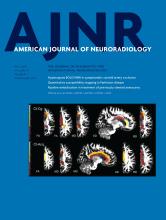Research ArticleFunctional
Impaired Cerebrovascular Reactivity Predicts Recurrent Symptoms in Patients with Carotid Artery Occlusion: A Hypercapnia BOLD fMRI Study
S.D. Goode, N. Altaf, S. Munshi, S.T.R. MacSweeney and D.P. Auer
American Journal of Neuroradiology May 2016, 37 (5) 904-909; DOI: https://doi.org/10.3174/ajnr.A4739
S.D. Goode
aFrom the Sheffield Vascular Institute (S.D.G.), Northern General Hospital, Sheffield, UK
bDepartment of Vascular Surgery (S.D.G., N.A., S.T.R.M.), Queens Medical Centre, Nottingham, UK
dDepartment of Radiological Sciences (S.D.G., N.A., D.P.A.), Sir Peter Mansfield Imaging Centre, University of Nottingham, Nottingham, UK.
N. Altaf
bDepartment of Vascular Surgery (S.D.G., N.A., S.T.R.M.), Queens Medical Centre, Nottingham, UK
dDepartment of Radiological Sciences (S.D.G., N.A., D.P.A.), Sir Peter Mansfield Imaging Centre, University of Nottingham, Nottingham, UK.
S. Munshi
cDepartment of Stroke Medicine (S.M.), Nottingham City Hospital, Nottingham, UK
S.T.R. MacSweeney
bDepartment of Vascular Surgery (S.D.G., N.A., S.T.R.M.), Queens Medical Centre, Nottingham, UK
D.P. Auer
dDepartment of Radiological Sciences (S.D.G., N.A., D.P.A.), Sir Peter Mansfield Imaging Centre, University of Nottingham, Nottingham, UK.

References
- 1.↵
- Powers WJ
- 2.↵
- Hankey GJ,
- Warlow CP
- 3.↵
- Klijn CJ,
- Kappelle LJ,
- van Huffelen AC, et al
- 4.↵
- Persoon S,
- Luitse MJ,
- de Borst GJ, et al
- 5.↵
- Grubb RL Jr.,
- Derdeyn CP,
- Fritsch SM, et al
- 6.↵
- Klijn CJ,
- Kappelle LJ,
- Algra A, et al
- 7.↵
- Bokkers RP,
- van Osch MJ,
- van der Worp HB, et al
- 8.↵
- Goode SD,
- Altaf N,
- Auer DP, et al
- 9.↵
- Derdeyn CP,
- Videen TO,
- Yundt KD, et al
- 10.↵
- Nemoto EM,
- Yonas H,
- Kuwabara H, et al
- 11.↵
- Markus H,
- Cullinane M
- 12.↵
- Yamauchi H,
- Fukuyama H,
- Nagahama Y, et al
- 13.↵
- Carlson AP,
- Yonas H,
- Chang YF, et al
- 14.↵
- 15.↵
- Goode SD,
- Krishan S,
- Alexakis C, et al
- 16.↵
- de Boorder MJ,
- van der Grond J,
- van Dongen AJ, et al
- 17.↵
- Beckmann CF,
- Jenkinson M,
- Smith SM
- 18.↵
- Woolrich MW,
- Behrens TE,
- Beckmann CF, et al
- 19.↵
- Kleiser BW,
- Widder B
- 20.↵
- Yonas H,
- Smith HA,
- Durham SR, et al
- 21.↵
- Widder B,
- Kleiser B,
- Krapf H
- 22.↵
- Webster MW,
- Makaroun MS,
- Steed DL, et al
- 23.↵
- Powers WJ,
- Tempel LW,
- Grubb RL Jr.
- 24.↵
- Hasegawa Y,
- Yamaguchi T,
- Tsuchiya T, et al
- 25.↵
- Yokota C,
- Hasegawa Y,
- Minematsu K, et al
- 26.↵
- Ogasawara K,
- Ogawa A,
- Yoshimoto T
- 27.↵
- Vernieri FP,
- Pasqualetti P,
- Passarelli F, et al
- 28.↵
- Kuroda S,
- Houkin K,
- Kamiyama H, et al
- 29.↵
- 30.↵
- 31.↵
- Jeffree RL,
- Stoodley MA
- 32.↵
- Powers WJ,
- Clarke WR,
- Grubb RL Jr., et al
- 33.↵
- Shojima M,
- Nemoto S,
- Morita A, et al
- 34.↵
- Gibbs JM,
- Wise RJ,
- Thomas DJ, et al
- 35.↵
- Mandell DM,
- Han JS,
- Poublanc J, et al
- 36.↵pEC/IC Bypass Study Group. Failure of extracranial-intracranial arterial bypass to reduce the risk of ischemic stroke: results of an international randomized trial. N Engl J Med 1985;313:1191–200 doi:10.1056/NEJM198511073131904 pmid:2865674
- 37.↵JET Study Group. Japanese EC-IC Bypass Trial (JET Study): the second interim analysis. Surg Cereb Stroke 2002;30:434–37 doi:10.2335/scs.30.434
- 38.↵
- Grubb RL Jr.,
- Powers WJ,
- Derdeyn CP, et al
- 39.↵
- Marshall RS,
- Festa JR,
- Cheung YK, et al
In this issue
American Journal of Neuroradiology
Vol. 37, Issue 5
1 May 2016
Advertisement
S.D. Goode, N. Altaf, S. Munshi, S.T.R. MacSweeney, D.P. Auer
Impaired Cerebrovascular Reactivity Predicts Recurrent Symptoms in Patients with Carotid Artery Occlusion: A Hypercapnia BOLD fMRI Study
American Journal of Neuroradiology May 2016, 37 (5) 904-909; DOI: 10.3174/ajnr.A4739
0 Responses
Jump to section
Related Articles
- No related articles found.
Cited By...
- No citing articles found.
This article has not yet been cited by articles in journals that are participating in Crossref Cited-by Linking.
More in this TOC Section
Functional
Similar Articles
Advertisement











